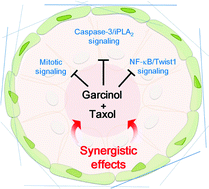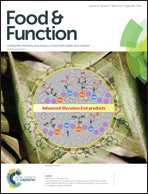Garcinol sensitizes breast cancer cells to Taxol through the suppression of caspase-3/iPLA2 and NF-κB/Twist1 signaling pathways in a mouse 4T1 breast tumor model
Abstract
Breast cancer is a significant threat to women's health and has high incidence and mortality. Metastasis in breast cancer patients is a major cause of cancer deaths among women worldwide. Clinical experience suggests that patients with metastatic triple-negative breast cancer (TNBC) relapse quickly and often have chemotherapy resistance. Taxol (paclitaxel) is an effective chemotherapeutic agent for treating metastatic breast cancer, but Taxol at high doses can cause adverse effects and recurrent resistance. Thus, the selection of a synergistic combination therapy is recommended, which is safer and has a more significant response rate than monotherapy. In this study, our strategy is to combine a low dose of Taxol (5 mg kg−1, i.p.) and garcinol (1 mg kg−1, i.g.) to investigate the synergistic antitumor and anti-metastasis effects and to determine the underlying mechanisms of these effects in vivo. For the in vivo study, metastasis-specific mouse mammary carcinoma 4T1 cells were inoculated in Balb/c mice to establish an orthotopic primary tumor and spontaneous metastasis model. Tumor growth and metastases were monitored. The mechanisms of synergistic efficacies were evaluated at different signaling pathways, including proliferation, survival, and epithelial–mesenchymal transition (EMT)-regulated metastatic propensity. We demonstrated that garcinol combined with Taxol significantly increased the therapeutic efficacy when compared with either treatment alone. The synergistic antitumor and anti-metastasis effects were enhanced primarily through the induction of Taxol-stimulated G2/M phase arrest and the inhibition of caspase-3/cytosolic Ca2+-independent phospholipase A2 (iPLA2) and nuclear factor-κB (NF-κB)/Twist-related protein 1 (Twist1) drive downstream events including tumor cell repopulation, survival, inflammation, angiogenesis, invasion, and EMT. Our current findings provide the first experimental evidence that a combination of a low dose of Taxol and garcinol is a promising therapeutic strategy for controlling advanced or metastatic breast cancer. Finally, our results also point to the possible role of NF-κB/Twist1 and caspase-3/iPLA2 signaling pathways as biomarkers to predict the tumor response to treatment.



 Please wait while we load your content...
Please wait while we load your content...